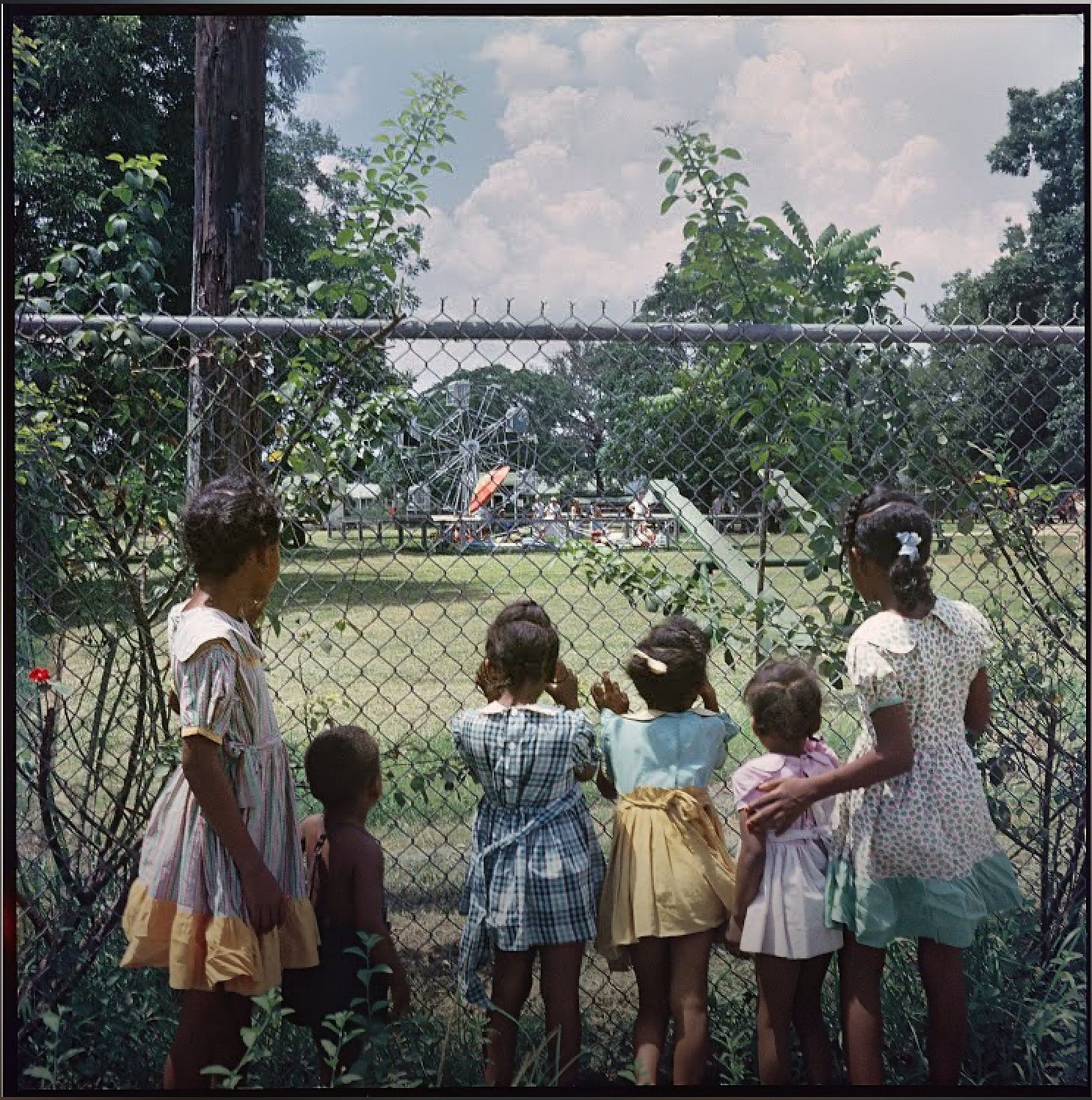Every other Friday, I share 5 things to consider. On the Fridays between, I mix things up. This is a Friday between.GM ☕️
Just one thing today…
In September 1956, Gordon Parks published a photography series in Life magazine titled “The Restraints, Open and Hidden.” The photo essay featured 26 images of the Thornton family of Mobile, Alabama, several of which were recently on loan at the Virginia Museum of Fine Arts.
I was able to visit the exhibition, A Long Arc,1 on an especially cold Friday last month. One photo in particular pulled me up short:2

I am still transfixed by this image’s contrast of out/in, such longing, curiosity, and the harsh juxtaposition of innocence and harm. The rigid boundary of a simple, surmountable chainlink fence. The disregard and all-around smallness of the distant adults, who chose not to wave these children in. It is senseless exclusion laid bare.
And.
Beyond the frame, Gordon Parks was listening with his eyes. He leveled his camera to meet the fence, but not perfectly so—for there was nothing perfect about the scene and nothing worth imitating in that fence. He gazed at six beautiful children in their Sunday best, who deserved so much better, and he resolved to tell their story. Pressing click, the traveling photographer captured a moment of truth.
It was a modest act that nonetheless involved big risk. As a northern Black photographer visiting Alabama to document segregation under Jim Crow, Parks put his personal safety on the line. The Thornton family also risked harassment and violence, with some of their members eventually leaving the state to seek safety.3 The photos they made together convey not only empathy, but also courage and determination.
Fueled by improbable hope that minds, laws, and a nation might change, one person taking one photograph planted a seed that, 69 years and millions of eyeballs later, landed in front of me. Today, I offer that seed to you.
The nation is precarious, and I know we can still be cruel. We exist so very far from our ideals. I worry, yes.
But from here, who knows? As adrienne maree brown teaches, “the future is unwritten.” Our story is yet unfolding.
Like Gordon Parks, we must embody every glimmer of possibility.
We must listen. We must gaze. And in the language of our particular talents, we must resolve to press click. Thus we will summon the improbable hope to seed a better future
again, and again, and again.
✨
“If we want a garden, we’re gonna have to sow the seeds. Plant a little happiness, let the roots run deep.”
ICYMI, last week I shared 5 Things to Consider:
Thank you for reading! This newsletter is a labor of love. 💌 To support it, you can upgrade to a paid subscription, share this post, or engage my services. You can learn more about my work at jenniferlphillips.com.
Peace,
Jenny
P.S. i hope you enjoy a beautiful sky this weekend👇🏼
A Long Arc: Photography and the American South Since 1845 was “co-curated by Sarah Kennel, PhD, VMFA's Aaron Siskind Curator of Photography and Director of the Raysor Center, with Gregory J. Harris, The Donald and Marilyn Keough Family Curator of Photography at the High Museum of Art, Atlanta.”
“Outside Looking In” struck such a deep chord with me that, rather than snap it on my phone, where it would surely get lost, I paused to sketch it in my notebook. I wanted a more permanent keepsake than a digital photo, and I wanted to look more closely. The result isn’t pretty, but it did its work to deepen my encounter.
Lily Lampe, “Revisiting Gordon Park’s ‘Segregation Story’ 60 Years Later,” L.A. Review of Books.






Wow. The photography project sounds like the one Walker Evans did with a sharecropper family in the Deep South that he and James Agee lived with, which became the photos in Agee's Let Us Now Praise Famous Men. Everything about this photo -- its content, framing, and history -- is remarkable.
"Outside Looking In" - a powerful reflection - one to inspire hope and action. Thank you!